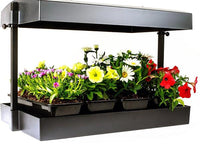Increasing trichome production is one of the top priorities for those who want top quality buds.
Why?
The size, number, and color of trichomes are major indicators of quality.
For those who don’t know, trichomes are the “hairs” and “crystals” on the flowers of the plant. These trichomes produce terpenes to protect the flowers from insects, animals, wind, fungi, and excessive ultraviolet (UV) radiation.
For HUMANS, more trichomes usually translates to higher potency. Trichomes produce cannabinoids like THC and CBD. They also produce antioxidants, terpenes, gooey resin, and other substances that make each plant and strain unique.
When you hear people raving about particular strains, they’ll often talk about the appearance of the trichomes.
Keep in mind that lots of healthy-looking trichomes don’t necessarily mean higher amounts of terpenes and cannabinoids. There are others, like a broad light spectrum and various environmental influences, that affect some strains more than others.
What factors contribute to trichome production? The strain plays a major role. The other factors are environmental.
4 Ways to Increase Grow Room Trichome Production
Below are four easy ways to increase trichome production by altering the growing environment. These are tips for indoor grow rooms, outdoor grows, and soil-free grows.
1. Add Probiotics & Sugar
The healthy bacteria in your yogurt can help produce more trichomes. These are lactobacillus bacteria strains.
Probiotics break down organic nutrients, making them more bioavailable for the plants. They allow the plants to absorb the nutrients more easily.
Another thing these friendly bacteria friends do is protect the plants from harmful bacteria, fungi, and molds.
They also break down sugars. The sugars become short-chain fatty acids after being metabolized. Your girls will take these fatty acids and make trichomes, terpenes, and cannabinoids with them.
Sugar is important here. Many growers add molasses to feed water during crucial times in the growing cycle, usually the flowering stage. Add sugars and probiotics together, and you may see an increase in trichome production.
You don’t need milk or yogurt to produce lacto probiotics. You can make a “magic potion” with brown rice, salt, water, and sugar.
You won’t get probiotics from white rice or other treated rice. It must be untreated rice, and organic is best. The healthy bacteria strains hang out on the surface. This is usually true for quinoa and barley, too.
How to Make Lacto:
You will need:
- 1 part sea salt
- 3 parts organic brown sugar
- 10 parts organic brown rice
- Water (10mL per gram of rice)
Put the rice, salt, and water in a bottle. Cap it and wait 30 minutes. Give it a good 100 shakes. Add sugar. Give it a few more shakes.
Store your Lacto in a warm and dark place.
Open your container a few times per day to release gas. Shake it once in a while.
After a few days, it will be foamy. It’s ready to add it to your feed water. The best time to add it is either night time (for outdoor grows) or lights out time (for indoor grow rooms).
Remember each time you open the container: Your Lacto will become foamy within one or several days, so make sure you don’t make a mess.
Instead of sealing the container with a cap or tight lid, you can use a cheese cloth or paper towel as an alternative. Attach one of them to the container with rubber bands. You will still want to manually release the gases at least a couple times a day.
If you use salt-based chemical fertilizers, you may be killing the probiotics.
Don’t Kill the Good Bacteria:
One great nutrient mixture that helps probiotic bacteria thrive is Technaflora ROOT 66. It quickens root development and makes your girls lush and sturdy, allowing for big buds. It’s designed for soil and soil-free grows and hydroponic systems.
Do you want to take a more measured approach when adding probiotic bacteria?
NPK RAW Microbes Grow gives you just the right amounts and types of healthy bacteria during the vegetative stage.
NPK RAW Microbes Bloom gives you just the right amounts and types of healthy bacteria during the flowering stage.
2. Shine More Light
The more hours of light, the more trichomes your girls will produce.
Ultraviolet light is especially helpful despite the fact that trichomes may block out some UV light. In fact, UV light encourages the plant to produce more trichomes to protect it from UV light.
UVB lamps are best for indoor grows. A lot of growers run a lamp for an hour or two per day during the second half of the flowering stage. Some do this during the entire flowering stage.
Keep in mind that UV light can kill some of the probiotic bacteria. That’s why it’s good to add more probiotics only after the lights go out.
If you want to save money on electricity and provide a full spectrum of light for your girls, consider LED grow lights.
3. Carefully Stress Out Your Plants
If you stress out your plants, they’ll go into survival mode and produce more trichomes to protect themselves from adverse conditions.
Of course, too much stress can kill a plant or ruin its health. The types and amount of stress must be controlled.
For example, near the end of the flowering stage, you can reduce relative humidity to about 30%. An extra benefit of this is a reduced risk of mold. You can do this if you have an indoor grow room or a grow tent.
4. Light Dep
Light dep is short for light deprivation. Normally, it’s a technique that used to trigger early flowering. Giving plants less than 12 hours of light during portions of the vegetative phase will trick them into thinking it’s time to produce flowers.
If your goal is higher trichome production, you can practice light dep near the end of the flowering phase to increase trichomes. This is possible for indoor grow rooms or for outdoor grows that use scaffolding, tents, or other structures that allow the grower to create dark conditions in the daytime.
Many growers will use the light dep technique for one, two, or more full days just before harvest.










